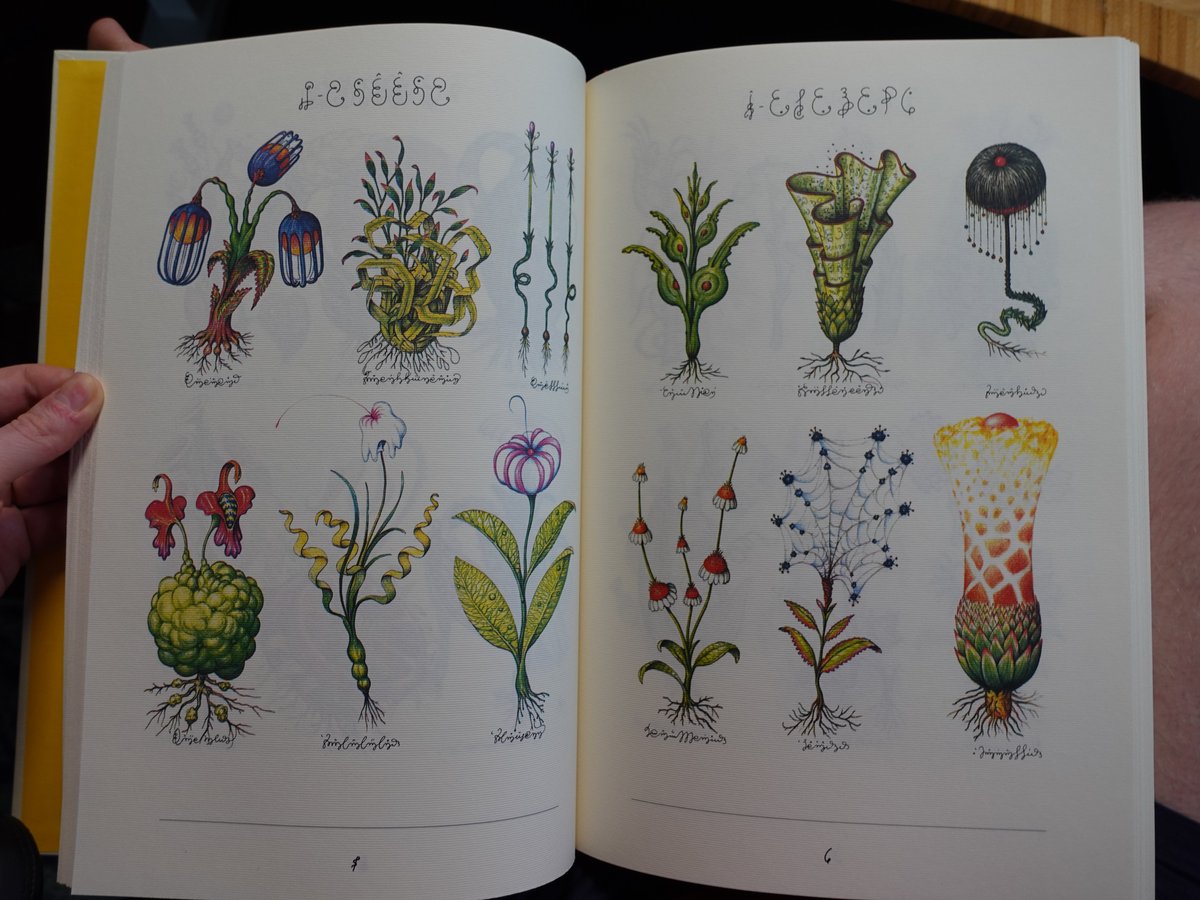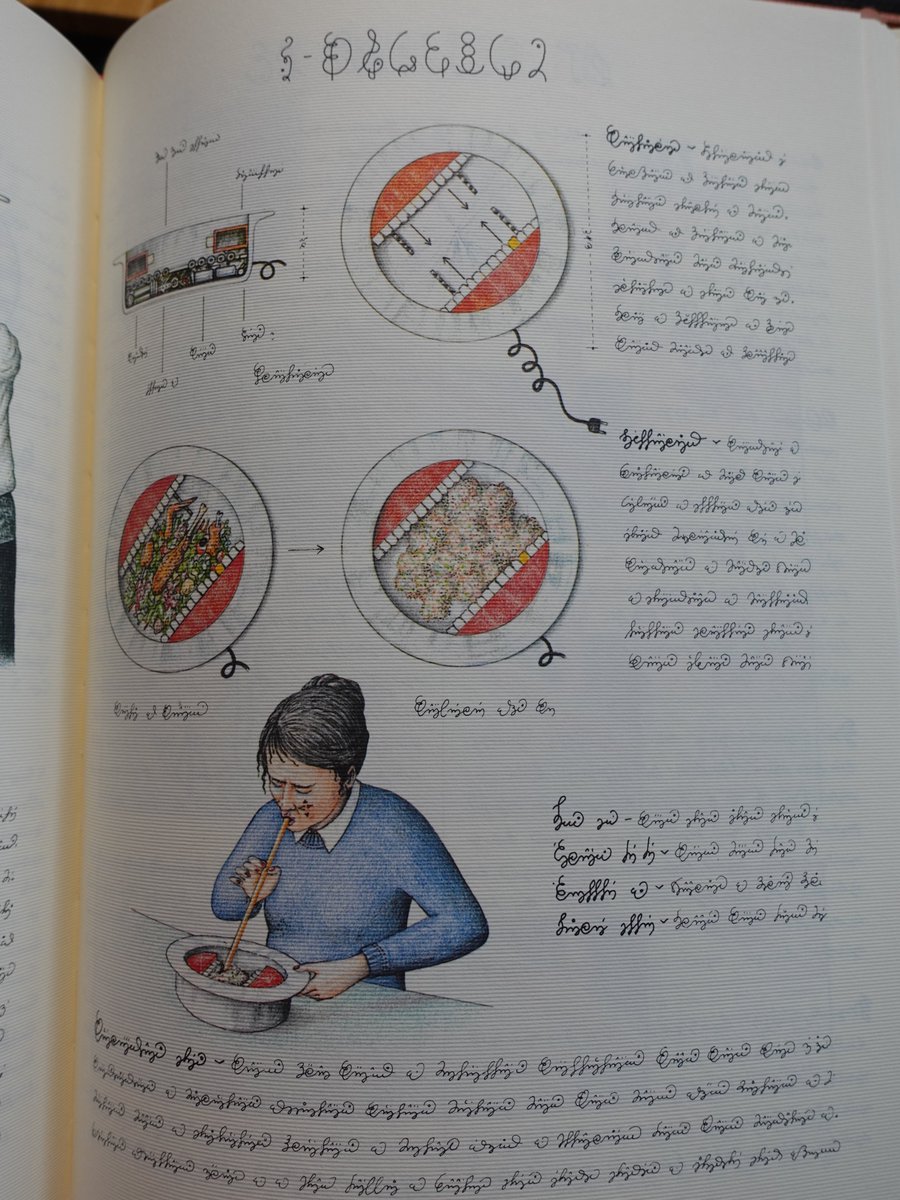It's the 40th birthday of the Codex Seraphinianus, an encyclopedia from a world that doesn't exist. Hundreds of pages—numbered in a base 21 system, not base 10—of colored pencil drawings and a constructed language.
I happen to own a copy, so let's flip through it together. 🧵

I happen to own a copy, so let's flip through it together. 🧵


Chapter 1 is about plants with unusual root systems or fruits. These avocado-like migratory trees uproot themselves to swim to new lands.
We even get a diagram of a plant that grows naturally into a chair shape and is harvested whole to produce chairs.



We even get a diagram of a plant that grows naturally into a chair shape and is harvested whole to produce chairs.




We can't talk about the Codex Seraphinianus without discussing the Voynich manuscript. Polish rare book dealer Wilfrid Voynich purchased the 15th-century book full of strange herbalism and astrology in Italy in 1912. Its purpose is debated, but @xkcd has one idea. 





Sometimes we see an early detail that takes on new context when combined with a later illustration. For instance, rainbows. Chapter 2 is about fauna, Chapter 5 is about machines and vehicles, and Chapter 11 is about architecture. 





Some fish and birds from Chapter 2. In Chapter 3 Serafini illustrates several kinds of animated legs that permeate this world’s culture. 





Chapter 4 is the weirdest: it’s full of abstract shapes and apparently showcases this world’s physics and chemistry.
how the heck am i supposed to write alt-text for this


how the heck am i supposed to write alt-text for this



Chapter 5: machines and vehicles. This illustration is believed by scholars to confirm Luigi Serafini's Italianness 

Chapters 6 and 7 detail history: colonizers with weapons or pens grafted onto them, and the customs and peoples of this world. 





Chapter 8! A chapter on this world’s WRITING. You’d think this would be the rosetta stone to the whole book. You’d be wrong
It appears the letters naturally occur in this world! Language comes from nature! But also there’s no em dash so how good can this language be


It appears the letters naturally occur in this world! Language comes from nature! But also there’s no em dash so how good can this language be



Serafini admitted in interviews that the writing in the Codex Seraphinianus is “asemic”—devoid of semantic meaning. The nonsense language is meant to make you feel like a child learning to read for the first time. (That hasn’t stopped people from aimlessly trying to decipher it.)
Chapters 9 and 10: culture. Food, clothing, card games, sports.
Check out that bowl that chews your food for you and then you drink the pre-chewed mush through a straw


Check out that bowl that chews your food for you and then you drink the pre-chewed mush through a straw



Pretentious magical realists (hi!) have a canon of beloved lit:
· Labyrinths, short stories by Jorge Luis Borges
· Invisible Cities, a novella by Italo Calvino
· @neilhimself (a professed Borges fan)
· Labyrinths, short stories by Jorge Luis Borges
· Invisible Cities, a novella by Italo Calvino
· @neilhimself (a professed Borges fan)
https://twitter.com/RobertGReeve/status/1377373336716607490?s=20
It's easy to say "Wow how could one person come up with all these mad illustrations? They're like nothing I've ever seen!"
But not even Serafini is an island. His work has touches of Hieronymus Bosch, M.C. Escher, and magical realist literature.
But not even Serafini is an island. His work has touches of Hieronymus Bosch, M.C. Escher, and magical realist literature.
In Borges’s 1940 short story “Tlön, Uqbar, Orbis Tertius,” the narrator hears a quote from a country called Uqbar, only listed in one out-of-print encyclopedia. An acquaintance dies and leaves him another encyclopedia detailing a world called Tlön, legendary to Uqbari people.
Borges’s encyclopedia comes from a secret society called Orbis Tertius, who through the power of belief alone cause the fictional world of Tlön to manifest in our world. In the near future, such artifacts become so popular and influential that Earth is slowly turning into Tlön.
I also have to mention Italian semiotician Umberto Eco (“the thinking man’s Dan Brown”). His novel Foucault’s Pendulum about the Knights Templar, conspiracy theories, and secret signs. And in The Name of the Rose, Eco’s character "Jorge of Burgos" lives in a labyrinthine library.
In 1972, Calvino wrote Invisible Cities. In it, Marco Polo reports to Kublai Khan about the many cities in his empire, and becomes his friend in the process. As you read, it becomes obvious the cities can’t be real (and even include anachronisms like automobiles and cameras).
Many cities' descriptions in Invisible Cities are less than a page, and the whole novella is written to be open to interpretation.
I see the cities as metaphors Marco Polo uses to teach Kublai Khan good morals and leadership.
I see the cities as metaphors Marco Polo uses to teach Kublai Khan good morals and leadership.
One invisible city—Octavia—hangs on ropes between two cliffs. When I saw this illustration in the Codex Seraphinianus, I was positive Serafini was inspired by it.
Imagine my surprise when I learned Calvino wrote an introduction to one edition of the Codex Seraphinianus.

Imagine my surprise when I learned Calvino wrote an introduction to one edition of the Codex Seraphinianus.


(In the D&D adventure Out of the Abyss, the players start in a drow prison colony called Velkynvelve. It's a spider-web city suspended between stalactites. @boymonster, you were one of the designers on that one—some Calvino fans on that team?) 



Lastly, in the back of my version of the Codex Seraphinianus there’s a little booklet with several translations of an introduction from Luigi Serafini where he reminisces on the creation of his magnum opus. 





In this year’s 40th anniversary edition, Luigi Serafini included yet more plates; he never stops working on it.
If this guided tour wasn't enough, I found a PDF of one of the earlier editions that you can flip through here: ubu.com/vp/Serafini.ht…
If this guided tour wasn't enough, I found a PDF of one of the earlier editions that you can flip through here: ubu.com/vp/Serafini.ht…
Lastly, a plug: I'm starting a Dungeons & Dragons talk show with different guests every Monday.
Tonight I've got @incandescaent, @alyssavisscher, and @laura_hirsb, who write, analyze, and edit some of the best D&D adventures around. twitch.tv/robertgreeve ⚔️



Tonight I've got @incandescaent, @alyssavisscher, and @laura_hirsb, who write, analyze, and edit some of the best D&D adventures around. twitch.tv/robertgreeve ⚔️




• • •
Missing some Tweet in this thread? You can try to
force a refresh













